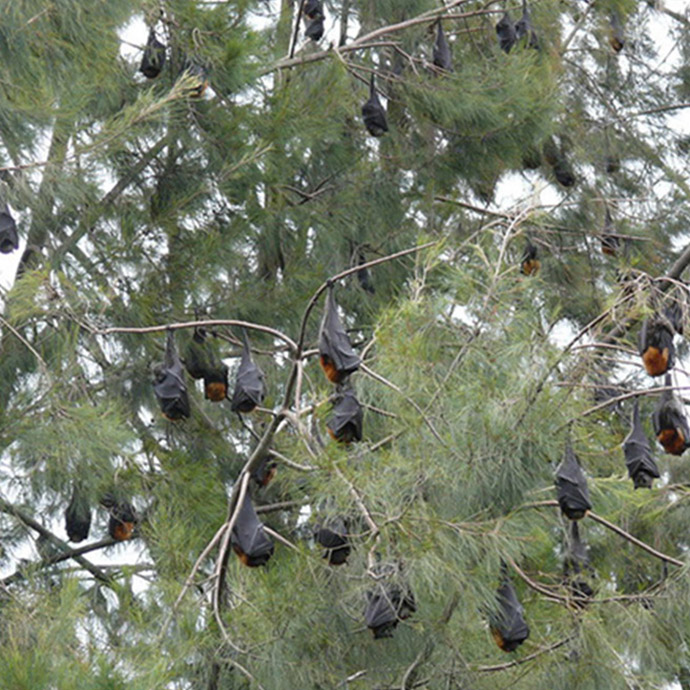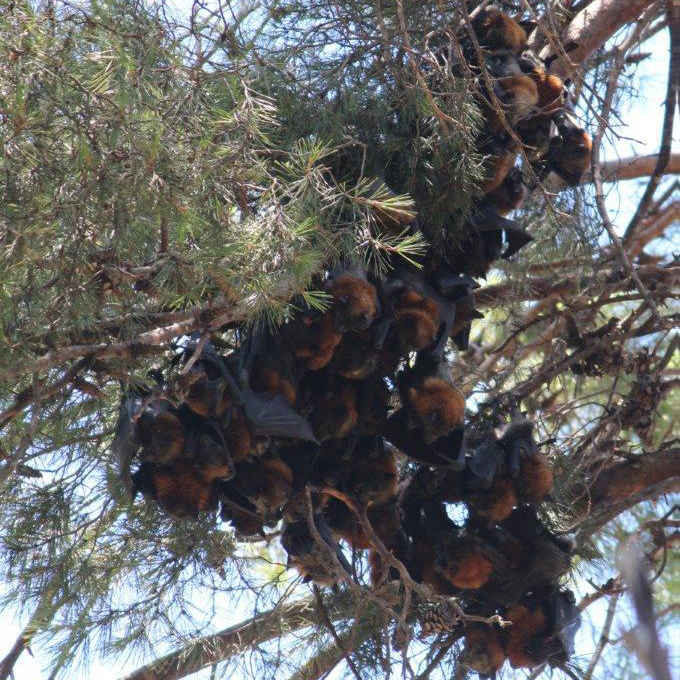During the day, flying-foxes roost in trees, and can be consequently susceptible to extreme weather conditions. These areas are known as flying-fox camps, which can range in size from several hectares to only a single tree, and may contain tens to thousands of individuals at any one time.
Heat stress – or hyperthermia – occurs when the body produces more heat than it can dissipate. Grey-headed and black flying-foxes are generally affected when temperatures exceed 42°C and roost vegetation in their camps doesn't provide enough shade refuge.
The severity of an extreme heat event on flying-foxes is likely to be reduced by:
- enough understorey and mid-storey vegetation for shelter from extreme heat
- dense crown vegetation to provide shade
- access to a water body.
Severity is likely to be increased when camps are disturbed at critical times during an extreme heat event, potentially forcing individuals to leave their cooler microhabitats and become fully exposed to the extreme heat.
Visit Responding to heat stress in flying-fox camps for information for licensed wildlife carers responding to heat stress events.
What are the signs of heat stress in flying-foxes?
When ambient temperatures rise above 35°C, flying-foxes express certain thermoregulatory behaviours to reduce their internal body temperature. These include:
- licking wrists and wing membranes
- wing-fanning
- panting
- shade-seeking, which may result in clustering
- descending to lower levels of vegetation
- descending to ground level.
The impacts of extreme heat events are likely to vary from site to site and event to event, depending the vegetation structure of the camp and conditions in the preceding days. Ambient temperature alone is not a sound indicator of whether flying-foxes are heat-stressed. Thermoregulatory behaviours in flying-foxes may be a more reliable indicator of whether they are affected.
Note: Because flying-foxes can lick and wing-fan for other reasons, these behaviours alone shouldn't be used to identify if they are heat-stressed.
What should I do if I find flying-foxes affected by heat stress?
Never touch a flying-fox. If you see flying-foxes panting or climbing down roost tree towards the ground, call a licensed wildlife rescue and rehabilitation provider or use the IFAW Wildlife Rescue App to quickly find the closest licensed carer. They can assess the situation and help the animals as needed.
Leave it to the experts. Helping heat-stressed flying-foxes requires licensed wildlife carers and land managers that are experienced in assessing and implementing appropriate interventions and avoiding additional harm to the animals.
In many cases, flying-foxes may be able to cope with the heat on their own. In these situations, it is best not to approach them, as approaching them may cause them to be disturbed and take flight, potentially weakening them further.
Keep pets away during extreme heat events
If flying-foxes have died during an extreme heat event, don't let domestic dogs and cats into the camp.
To date, there have been no cases of cats and dogs becoming infected following contact with a bat infected with Australian bat lyssavirus. However, it is theoretically possible that a pet that has come into contact with an infected bat could contract the virus and could then transmit that infection to a human.

